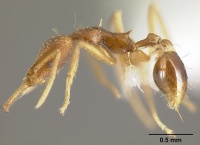Strumigenys diaptyxis
| Strumigenys diaptyxis | |
|---|---|

| |
| Scientific classification | |
| Kingdom: | Animalia |
| Phylum: | Arthropoda |
| Class: | Insecta |
| Order: | Hymenoptera |
| Family: | Formicidae |
| Subfamily: | Myrmicinae |
| Tribe: | Attini |
| Genus: | Strumigenys |
| Species: | S. diaptyxis |
| Binomial name | |
| Strumigenys diaptyxis Bolton, 2000 | |
The small number of collections of this species are all from wet forest habitat. The holotype, a lone worker from the Penas Blancas Valley, was collected at night from low vegetation in mature wet forest.
Identification
Bolton (2000) - A member of the Strumigenys emeryi-group. The lack of mesonotal flagellate hairs, reduction of propodeal lamella together with presence of propodeal lacuna, deep ventral spongiform curtain on petiole and form of sculpture combine to make this species easily recognisable.
Longino (Ants of Costa Rica) - Apical fork of mandible with one intercalary tooth; mandible with small preapical tooth very close to apical fork, and a minute denticle near the apical third of mandible length; gaster smooth and shining, with setae stiff, straight, slightly thickened.
This species shares characters with both Strumigenys micretes and Strumigenys nevermanni. It is intermediate in size between micretes and nevermanni. It has gastral pilosity more like nevermanni than micretes. It has a uniformly punctate face, in contrast to the other two species which have more rugose faces.
Keys including this Species
Distribution
Latitudinal Distribution Pattern
Latitudinal Range: 10.317° to 10.317°.
| North Temperate |
North Subtropical |
Tropical | South Subtropical |
South Temperate |
- Source: AntMaps
Distribution based on Regional Taxon Lists
Neotropical Region: Costa Rica (type locality), Nicaragua.
Distribution based on AntMaps
Distribution based on AntWeb specimens
Check data from AntWeb
Countries Occupied
| Number of countries occupied by this species based on AntWiki Regional Taxon Lists. In general, fewer countries occupied indicates a narrower range, while more countries indicates a more widespread species. |

|
Estimated Abundance
| Relative abundance based on number of AntMaps records per species (this species within the purple bar). Fewer records (to the left) indicates a less abundant/encountered species while more records (to the right) indicates more abundant/encountered species. |

|
Biology
|
Castes
Images from AntWeb

| |
| Worker. Specimen code jtlc000004299. Photographer D. J. Cox, uploaded by California Academy of Sciences. | Owned by JTLC. |
Nomenclature
The following information is derived from Barry Bolton's Online Catalogue of the Ants of the World.
- diaptyxis. Strumigenys diaptyxis Bolton, 2000: 513 (w.) COSTA RICA.
Unless otherwise noted the text for the remainder of this section is reported from the publication that includes the original description.
Description
Worker
Holotype. TL 2.8, HL 0.70, HW 0.50, CI 71, ML 0.41, MI 59, SL 0.46, SI 92, PW 0.31, AL 0.72. Mandible with a small preapical tooth close to the apicodorsal tooth; left mandible also with a vestigial denticle proximal to the preapical tooth (implies possibility of variation such as is common elsewhere in the group). Pronotal humeral hair long, fine and flagellate; all other standing hairs simple or weakly spatulate apically. Without flagellate hairs on dorsolateral margin of head, mesonotum, waist segments or first gastral tergite. The two pairs of standing hairs on cephalic dorsum stiff and erect. Dorsum of head reticulate-punctate, without superimposed rugulose sculpture. Pronotal dorsum shagreenate to finely superficially reticulate-punctate, not sharply reticulate-punctate and without longitudinal rugulae. Mesopleuron mostly smooth, metapleuron and side of propodeum smooth anteriorly, feebly punctulate posteriorly. Propodeum with a pair of narrowly triangular spines, lamella immediately below spine narrow, feebly convex in its lower part around the weakly developed propodeal lacuna. Ventral surface of petiole with a spongiform curtain that at maximum is over half the depth of the peduncle. Dorsum of petiole node slightly longer than broad, weakly reticulate-punctate. Disc of postpetiole unsculptured and basigastral costulae shorter than postpetiole disc.
Type Material
Holotype worker, Costa Rica: Provo Alajuela, Rio Penas Blancas, 10°19'N, 84°43'W, 800 m., 26-28.iv.1987, #1618-S, wet forest, workers on vegetation at night (J. Longino) (The Natural History Museum).
References
- Bolton, B. 2000. The ant tribe Dacetini. Memoirs of the American Entomological Institute. 65:1-1028. (page 513, worker described)
References based on Global Ant Biodiversity Informatics
- Fernández, F. and S. Sendoya. 2004. Lista de las hormigas neotropicales. Biota Colombiana Volume 5, Number 1.
- Longino J. T. 2013. Ants of Nicargua. Consulted on 18 Jan 2013. https://sites.google.com/site/longinollama/reports/ants-of-nicaragua

